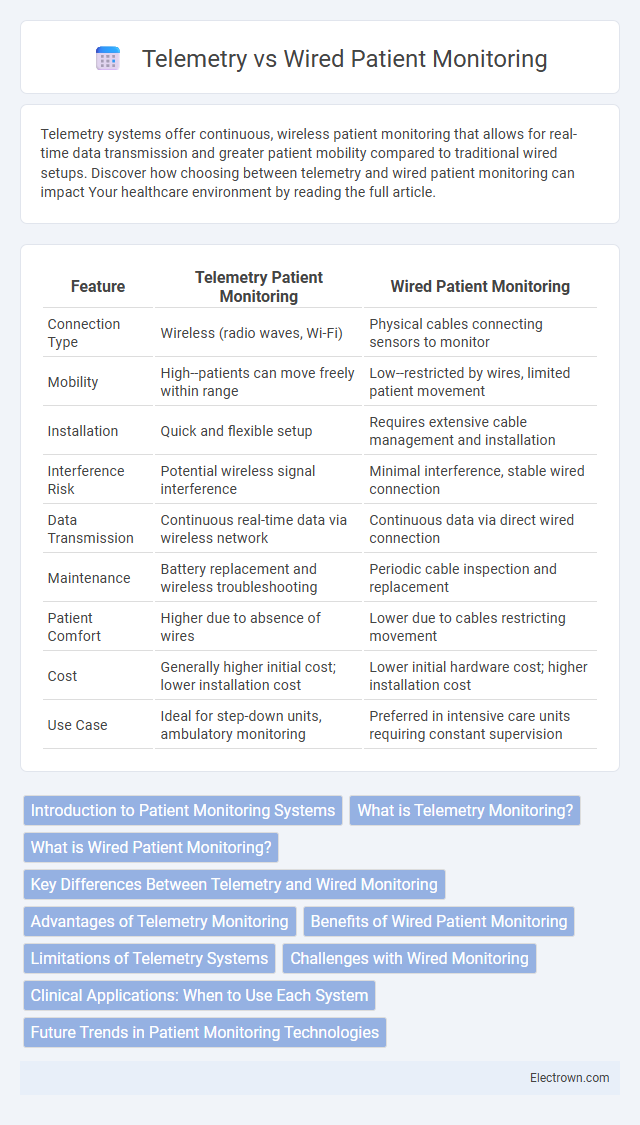Telemetry systems offer continuous, wireless patient monitoring that allows for real-time data transmission and greater patient mobility compared to traditional wired setups. Discover how choosing between telemetry and wired patient monitoring can impact Your healthcare environment by reading the full article.
Table of Comparison
| Feature | Telemetry Patient Monitoring | Wired Patient Monitoring |
|---|---|---|
| Connection Type | Wireless (radio waves, Wi-Fi) | Physical cables connecting sensors to monitor |
| Mobility | High--patients can move freely within range | Low--restricted by wires, limited patient movement |
| Installation | Quick and flexible setup | Requires extensive cable management and installation |
| Interference Risk | Potential wireless signal interference | Minimal interference, stable wired connection |
| Data Transmission | Continuous real-time data via wireless network | Continuous data via direct wired connection |
| Maintenance | Battery replacement and wireless troubleshooting | Periodic cable inspection and replacement |
| Patient Comfort | Higher due to absence of wires | Lower due to cables restricting movement |
| Cost | Generally higher initial cost; lower installation cost | Lower initial hardware cost; higher installation cost |
| Use Case | Ideal for step-down units, ambulatory monitoring | Preferred in intensive care units requiring constant supervision |
Introduction to Patient Monitoring Systems
Patient monitoring systems encompass telemetry and wired technologies, each designed to continuously track vital signs like heart rate, blood pressure, and oxygen saturation. Telemetry systems offer wireless data transmission, enabling greater patient mobility and real-time remote monitoring. Wired systems provide stable connections with minimal interference, ensuring consistent data accuracy for critical care environments.
What is Telemetry Monitoring?
Telemetry monitoring is a wireless system used in healthcare to continuously track a patient's vital signs, such as heart rate and respiratory status, by transmitting real-time data to a central monitoring station. This technology allows for greater mobility and comfort compared to wired patient monitoring, which relies on physical connections to sensors and devices. Telemetry enhances patient safety by enabling your healthcare team to detect and respond to changes promptly, even when you are not confined to a hospital bed.
What is Wired Patient Monitoring?
Wired patient monitoring involves the continuous use of physical cables connected to sensors on a patient's body to track vital signs such as heart rate, oxygen levels, and blood pressure in real-time. This method ensures high accuracy and stability of data transmission without interference, making it ideal for critical care settings. Your medical team relies on wired patient monitoring systems to provide precise and consistent health data, enabling timely interventions.
Key Differences Between Telemetry and Wired Monitoring
Telemetry patient monitoring offers wireless data transmission, enabling real-time remote observation of vital signs, while wired monitoring relies on physical connections for data transfer, restricting patient mobility. Telemetry systems enhance patient comfort and mobility by eliminating cables, whereas wired monitoring provides continuous, stable data streams but limits movement. Key differences include the mode of data transmission, patient mobility levels, and implementation complexity in healthcare settings.
Advantages of Telemetry Monitoring
Telemetry monitoring offers significant advantages over wired patient monitoring by providing continuous, real-time data transmission without restricting patient mobility, which enhances comfort and promotes faster recovery. This wireless capability allows healthcare providers to monitor vital signs remotely and respond quickly to critical changes, improving patient safety and care efficiency. You benefit from reduced clutter and infection risk associated with wires, creating a more flexible and hygienic patient environment.
Benefits of Wired Patient Monitoring
Wired patient monitoring offers consistent, high-quality data transmission crucial for accurate and reliable vital sign tracking in clinical settings. Its stable connections minimize the risk of signal loss or interference, ensuring continuous monitoring during critical care. You can rely on wired systems for real-time, uninterrupted patient status updates that support timely medical interventions.
Limitations of Telemetry Systems
Telemetry systems face limitations such as restricted range, potential signal interference, and dependency on battery life, which can compromise continuous patient monitoring. Wired patient monitoring offers more reliable data transmission and consistent power supply, reducing the risk of signal loss and ensuring accurate vital sign measurements. Clinical environments requiring high patient acuity often prefer wired systems due to these inherent telemetry constraints.
Challenges with Wired Monitoring
Wired patient monitoring systems pose challenges such as limited patient mobility due to tethered connections, increasing discomfort and risk of accidental disconnections during movement or routine care. These systems often require more maintenance and are prone to signal interference caused by cable wear or environmental factors, leading to potential data inaccuracies. Healthcare staff also face increased workload managing physical wires, which can complicate emergency interventions and infection control protocols.
Clinical Applications: When to Use Each System
Telemetry systems are ideal for continuous remote monitoring of patients with stable conditions who require mobility and real-time data transmission, such as those recovering from surgery or managing chronic illnesses. Wired patient monitoring is preferred in intensive care units or perioperative settings where constant, high-fidelity data and immediate clinical interventions are critical. Your choice depends on the clinical scenario, balancing the need for patient mobility with the requirement for precise and continuous monitoring.
Future Trends in Patient Monitoring Technologies
Future trends in patient monitoring technologies emphasize wireless telemetry systems that provide continuous, real-time data transmission, enhancing patient mobility and comfort compared to traditional wired setups. Integration of artificial intelligence and machine learning algorithms enables predictive analytics for early detection of patient deterioration. Advances in wearable sensors and IoT connectivity are expected to drive broader adoption of telemetry, reducing reliance on wired monitors and improving remote patient management outcomes.
Telemetry vs Wired Patient Monitoring Infographic

 electrown.com
electrown.com